Can You Use a Paddleboard to Surf?
Paddle boarding may have gotten its start on the islands of Hawaii, but its popularity is circling the globe. First used as a mode of navigating the waters from island to island, paddleboards are now one of the most versatile personal watercraft on the market.
Yes, you can use a paddle board to surf. It is known as SUP surfing (Stand-Up Paddleboards to Surf) However not every paddleboard is built for SUP surfing. Finding the right paddleboard for surfing follows the same guidelines as selecting a surfboard. More importantly, a SUP surfer needs to know the laws of nature when riding the ocean.
SUP surfing is one of the most exhilarating ways to use your paddleboard. Riding a wave is a whole different animal than paddling down a calm stream. Switching gears on your paddleboard to become a SUP surfer requires preparation and a proper board.
Why SUPs are Great for Surfing
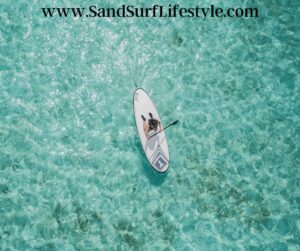 The style of the paddleboard’s hull has been modeled after traditional surfboards. Wider and flatter, this planing style of a hull is designed to glide atop the water. The entry rocker nose of the paddleboard enables the SUP to skim across the water as it achieves maximum velocity.
The style of the paddleboard’s hull has been modeled after traditional surfboards. Wider and flatter, this planing style of a hull is designed to glide atop the water. The entry rocker nose of the paddleboard enables the SUP to skim across the water as it achieves maximum velocity.
Having a paddle in hand adds to the efficiency of the SUP as a surfboard. Using a paddle gives you a stronger propelling force when compared to arm-paddling like a surfer. Together with the entry rocker nose, a SUP surfer can reach the waves faster with the help of their paddle.
Statistically speaking, a SUP surfer can catch more waves than a traditional surfer. This is simply because a SUP surfer is already standing when they catch the wave. No time is lost in popping to your stance leaving more time to ride the surf.
What’s really great about SUP surfing is the strategic and often majestic view of the oceanic scenery. Being in the standing position throughout your ride on a SUP provides you greater visibility. This gives you:
- The ability to scope the horizon for incoming waves at a greater distance.
- A better line of sight to see other surfers in the water to avoid collisions.
- A superior viewpoint for gauging the size and speed of the waves helps you prepare to brace for the intensity of the water’s shift in direction and velocity.
Factors to Consider
SUP surfing is accomplished by making a few adjustments to your technique, your board choice, and your tolerance of crowds. All three of these factors play a role in you safely enjoying the world of surfers. Not addressing any of these components properly before SUP surfing can result in serious injury to you or others around you.
Water Factors
Traditional paddle boarding is done on placid bodies of water or slow-moving rivers and streams. Learning how to keep your balance while standing on moving water is more difficult than when on solid land. Figuring out how to maintain that center of gravity when the water beneath you can drop away in a flash is another trick altogether.
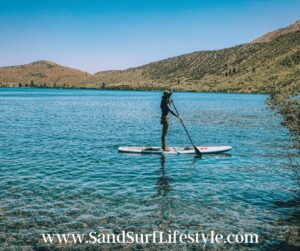 The fluid and unpredictable movement of the ocean’s waves requires a greater ability to balance the mass of your body. The ever-changing center of gravity from the rise and fall of the waves takes a quick muscle response to maintain stability on your feet. Being quick on your feet in this instance means the difference between staying on your board or flailing through the air
The fluid and unpredictable movement of the ocean’s waves requires a greater ability to balance the mass of your body. The ever-changing center of gravity from the rise and fall of the waves takes a quick muscle response to maintain stability on your feet. Being quick on your feet in this instance means the difference between staying on your board or flailing through the air
Every surfer, traditional and SUP, is going to fall while learning how to maintain their balance on a moving stage. Over time, your muscles will know how to respond to those undulating movements of the water. Your body’s muscle memory will react with cat-like reflexes to shift body weight, keeping you on your feet and on your board.
Practice maintaining your balance and center of gravity while safely on solid ground before jumping right into SUP surfing. Find a park with those low to the ground balance beams to get a feel for riding a paddleboard. Another method for honing your balance is by walking heel to toe in a straight line.
One of the greatest methods for strengthening your balance muscles and mastering center of gravity control is the practice of yoga. You can create a routine of poses that are specifically designed to bolster key muscles. In fact, there is even a yoga position that Jaime Amor, creator of the story-based, Cosmic Kids Yoga, refers to as the surfer pose.
Maintaining Center of Gravity and Balance
- Shifting weight from one side to the other to compensate for the changing angles of the paddleboard to the water and the water to the horizon
- When to bend or straighten the knee joints and ankle joints and by how much on each leg to balance body weight
- Movements of the hips from left to right and right to left along with shifting forward or back to maintain a balanced center
Water Safety
Being able to stay on your paddleboard when surfing requires a keen awareness of the conditions of the water, wind, and weather. You need to be a stronger swimmer when battling the waves of an ocean as compared to swimming in a river or lake. Surfers know the most important aspect of water safety is reading the day’s surf report.
Reported in a similar fashion to weekly weather, the surf reports are created to inform beachgoers of key information. These reports often include:
- Wave height
- Swell height, period, and direction
- Wind strength and direction
- Tide conditions
SUP surfers who are just getting started should look for wave heights of 2-3 feet. The swell height and duration are important to note because of how big of a difference a little change can make in the surf conditions.
| Swell Height: 4 feet | Swell Height: 5 feet |
| Duration: 10 seconds | Duration: 16 seconds |
| Good for Beginners Surfers | Good for Advanced Surfers |
Wind direction plays an important role in the safety of SUP surfing and watersports in general.
| Onshore Winds | Offshore Winds |
| ❖ Wind blowing toward the beach from the water ❖ Choppy, rough, and difficult waters to surf | ❖ Wind blowing from the beach out over the water ❖ Slow waves and smoother waters |
As a SUP surfer, you must become familiar with the tides and know how they affect the surf conditions.
- Low tides are shallow and difficult to surf
- High tides tend to flatten out the surf
- Mid-tides are the perfect time to catch the best waves
Not sure how to get back up onto a paddleboard after falling off? Find out how to get back on here.
Board Factors
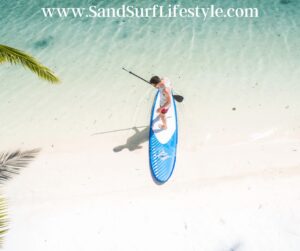 Paddleboards are versatile and can be modified to handle different water conditions. They are also designed to accommodate the body style of the rider. This is why you will need to know your height, weight, and wingspan when renting or purchasing a paddleboard for surfing.
Paddleboards are versatile and can be modified to handle different water conditions. They are also designed to accommodate the body style of the rider. This is why you will need to know your height, weight, and wingspan when renting or purchasing a paddleboard for surfing.
Due to their added buoyancy and larger surface area, paddleboards are easier to stand on than surfboards. Paddleboards are wider and longer than traditional surfboards making them great for first-time surfers. The extra room and floatation make it easier to maintain your balance and stability during your ride.
Surfboards were specifically designed to quickly steer in and out of the unpredictable crashing waves. Paddleboards are beginning to mimic those features that help surfers slice through the water. Shorter paddleboards are ideal for SUP surfing as they closely match the 6-8 foot range of traditional surfboard lengths. For the greatest maneuverability, choose a board in a width range of 30-31 inches.
The weight of the paddleboard and paddle are the final aspects involved when choosing your equipment for SUP surfing. You must be able to carry them from the beach to the water without tiring out. If you’re too weak from carrying the paddleboard to the water, you’ll be too exhausted to stay upright on your board.
Choosing a paddleboard that is as light as possible will make it easier to get it into the water. In addition, picking the lightest paddle will reduce your workload. The paddle is necessary for executing meticulous locomotion through the water. The weight of the paddle is crucial in being able to make rapid adjustments
| Surf Stand-up Paddleboards | Race Stand-up Paddleboards |
| ● Narrow nose and tail ● Shorter than other paddleboards ● 9-10 feet long ● 30-31 inches wide ● 4 inches thick | ● Designed for speed and agility ● Recommended for highly skilled surfers ● 8-10 feet long ● 29-31 inches wide ● 3-5 inches thick |
People Factor
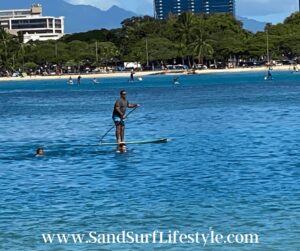 Beaches tend to be much more crowded with people enjoying the water than the lakes and rivers normally traveled by paddleboarders. You will need to be much more aware of your surroundings while in the water. Nobody likes the newbie who keeps crashing into everyone, limbs flailing about wildly.
Beaches tend to be much more crowded with people enjoying the water than the lakes and rivers normally traveled by paddleboarders. You will need to be much more aware of your surroundings while in the water. Nobody likes the newbie who keeps crashing into everyone, limbs flailing about wildly.
SUP surfing on populous waters means keeping your eyes on a swivel to know where others are and by how close. Keeping track of the swirls of people in between the swells of the waves is important for everyone’s safety. Not crashing into another surfer is just as important as not crashing into the beach.
Many surfers and SUP surfers alike, recommend those new to either watersport take lessons before entering the water. There are a number of safety regulations and rules of etiquette that everyone needs to learn before they surf. SUP surfing instructions can be obtained online but it’s highly suggested to get in-person lessons for best results.
Related Questions
How much does a paddleboard for SUP surfing cost?
Inflatable paddleboards will be your least expensive purchasing option. A high-quality inflatable paddleboard will cost around $300. Solid paddleboards are heavy to carry and harder on the wallet starting at $600.
Is SUP surfing a competitive sport like traditional surfing?
The 2021 USA Surfing Championship was held at Oceanside, California in mid-June. Events included SUP surfing for men and women divided into two age groups. The competition also had events for youth under the age of 18.
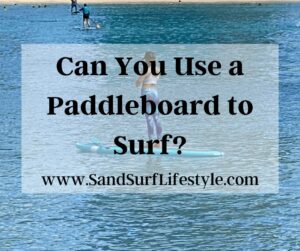
Please note: This blog post is for educational purposes only and does not constitute legal or medical advice. Please consult a legal expert or medical professional to address your specific needs.

